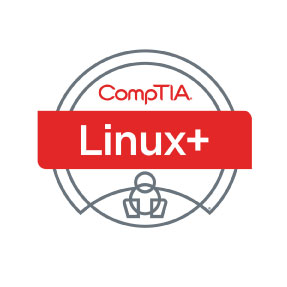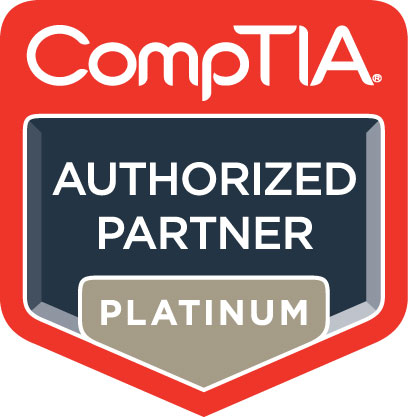Course Outline

CompTIA Linux+ Bootcamp
 CT105 | Day | 5 Days
CT105 | Day | 5 DaysThe CompTIA Linux+ course builds on your existing user-level knowledge and experience with the Linux operating system to present fundamental skills and concepts that you will use on the job in any type of Linux career. This course will benefit you in troubleshooting, installation, or maintenance of Linux environment, or if you are preparing for any type of Linux-related career, it provides the background knowledge and skills you will require to be successful.
Click here to find your place on the CompTIA Roadmap.
Upcoming Dates:
- May 13, 2024 - May 17, 2024
- Jun 10, 2024 - Jun 14, 2024
- Jul 22, 2024 - Jul 26, 2024
- Aug 19, 2024 - Aug 23, 2024
- Sep 23, 2024 - Sep 27, 2024


Who should take this course
This course is intended for entry-level computer support professionals with basic knowledge of computer hardware, software, and operating systems, who wish to increase their knowledge and understanding of Linux concepts and skills to prepare for a career in Linux support or administration, or to prepare for the CompTIA Linux+ Exam XK0-005.
Course Objectives
After completing this course, students will be able to:
- Identify basic Linux concepts and perform basic Linux tasks.
- Manage user and group accounts.
- Manage partitions and the Linux filesystem.
- Manage various files in Linux.
- Work with Linux permissions and ownership.
- Print files.
- Manage packages.
- Manage kernel services.
- Work with the Bash shell and shell scripts.
- Manage jobs and processes.
- Manage system services.
- Configure network services.
- Configure basic Internet services.
- Implement measures to secure a Linux system.
- Manage hardware associated with Linux systems.
- Troubleshoot Linux system issues.
- Install the Linux operating system.
- Configure the GUI.
Course Outline
Lesson 1:Performing Basic Linux Tasks
Topic A:Identify the History and Development of Linux
Topic B:Enter Shell Commands
Topic C:Get Help Using Linux
Topic D:Start and Stop Linux
Lesson 2:Managing User and Group Accounts
Topic A:Create User and Group Accounts
Topic B:Configure User Profiles
Topic C:Administer User and Group Accounts
Lesson 3:Managing Partitions and the Linux Filesystem
Topic A:Create Partitions
Topic B:Navigate Through the Linux Filesystem
Topic C:Manage the Filesystem
Topic D:Maintain the Filesystem
Lesson 4:Managing Files in Linux
Topic A:Create and Edit Text Files
Topic B:Locate Files
Topic C:Search Text Using Regular Expressions
Topic D:Apply Filters to Text Streams
Topic E:Link Files
Topic F:Back Up and Restore Files
Topic G:Manage Databases Using MariaDB
Lesson 5:Managing Linux Permissions and Ownership
Topic A:Modify File and Directory Permissions
Topic B:Modify Default Permissions
Topic C:Modify File and Directory Ownership
Topic D:Set Special Permissions and Attributes
Lesson 6:Printing Files
Topic A:Configure a Local Printer
Topic B:Print Files
Topic C:Configure Remote Printing
Lesson 7:Managing Packages
Topic A:Manage Packages Using RPM
Topic B:Verify Packages
Topic C:Upgrade Packages
Topic D:Configure Repositories
Topic E:Manage Packages Using YUM
Topic F:Advanced Package and Application Management
Lesson 8:Managing Kernel Services
Topic A:Explore the Linux Kernel
Topic B:Customize Kernel Modules
Topic C:Create an initrd Image
Topic D:Manage Device Drivers and Hardware Devices
Topic E:Monitor Processes and Resources
Lesson 9:Working with the Bash Shell and Shell Scripts
Topic A:Perform Basic Bash Shell Operations
Topic B:Write a Bash Shell Script
Topic C:Customize the Bash Shell
Topic D:Redirect Standard Input and Output
Topic E:Use Control Statements in Shell Scripts
Lesson 10:Managing Jobs and Processes
Topic A:Manage Jobs and Background Processes
Topic B:Manage Processes Using the Process Table
Topic C:Delay and Detach Jobs
Topic D:Schedule Jobs
Topic E:Maintain the System Time
Lesson 11:Managing System Services
Topic A:Configure System Services
Topic B:Monitor System Logs
Topic C:Configure Security-Enhanced Linux (SELinux)
Lesson 12:Configuring Network Services
Topic A:Connect to a Network
Topic B:Configure Routes
Topic C:Configure Client Network Services
Topic D:Manage Remote Network Systems
Lesson 13:Configuring Basic Internet Services
Topic A:Configure Email Services
Topic B:Control Internet Services
Lesson 14:Securing Linux
Topic A:Implement Basic System Security
Topic B:Secure User Accounts
Lesson 15:Managing Hardware
Topic A:Identify Common Hardware Components and Resources
Topic B:Configure Removable Hardware
Topic C:Configure Disk Quotas
Lesson 16:Troubleshooting Linux Systems
Topic A:Troubleshoot System-Based Issues
Topic B:Troubleshoot Hardware Issues
Topic C:Troubleshoot Network Connection and Security Issues
Lesson 17:Installing Linux
Topic A:Prepare for Installation
Topic B:The Linux Boot Process
Topic C:Configure GRUB
Topic D:Install the Operating System
Lesson 18:Configuring the GUI
Topic A:Implement X
Topic B:Customize the Display Manager
Topic C:Enable Accessibility Settings in Linux






















